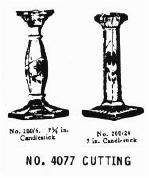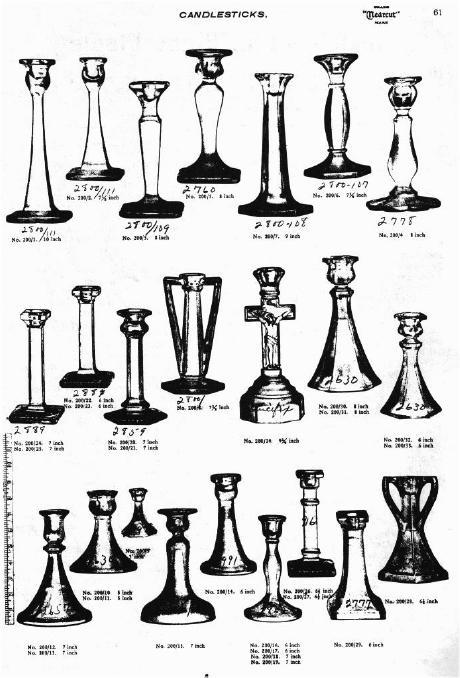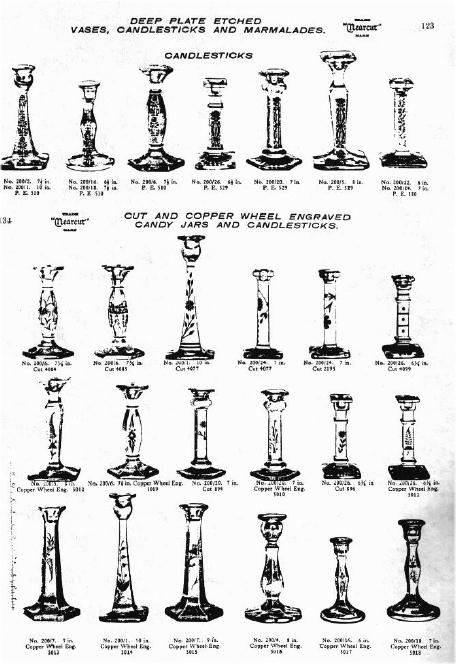Candlesticks, Candelabra, and Epergnes Part I
by Mark A. Nye
Issue No. 213 - January 1991
As announced at the November 1990 Quarterly Meeting, the theme for the 1991 N.C.C., Inc., Convention will be "Candlesticks," and so, we begin a new series of articles that will lead us up to the Convention next June.
For now, we will skip the Nearcut Era and begin the review of Cambridge candlesticks with the Cambridge Glass Company Catalog No. 10, issued circa 1920-1921. There is in existence a copy of this catalog signed by Mr. Bennett, with the note "correct 10/5/21." The latter would indicate it had been published prior to October 1921, perhaps during the early part of the year or before.
Editor's Note: There are two Catalog pages located at the end of this article which are referenced in the text below.
This catalog, regardless of the exact issue date, came out during the transition period between the imitation cut and patterned glass of the early years and the lighter pressed and blown wares, in color and crystal, plain and decorated, produced beginning in the 1920-1921 period, that today's collectors are most familiar with. It was this catalog that first started to feature the vast array of candlesticks, candelabrum and epergnes Cambridge issued over the years. There were candlesticks in previous catalogs, but not to the extent seen in No. 10, and these will be covered in a future article.
Page 61 of Catalog No. 10 (end of article) was devoted entirely to candlesticks, and on this page were 23 candlestick illustrations, with notations for another 11. These were numbered #200/1 through #200/34, with the latter being a crucifix candlestick. Several of these candlesticks had been previously seen in a pre-1920 catalog with different numbers and at least one or two had been altered slightly during the ensuing years. As you can see from the accompanying illustration, there were not 34 different candlesticks. In many instances there were two sizes of the same stick, as well as full finished or unfinished foot versions.
Items #200/1 through #200/8 were described, in an undated price list for Catalog No. 10, as cut top and bottom and ranged in price per dozen from $18 for #200/1 to $12 for the #200/1 and #220/6 when purchased in barrel lots. In less than barrel lots, the price jumped to $19.80 and $13.20, respectively. Take note of the 3" #200/9, shown at the bottom of the page, described as a 3" unfinished birthday candlestick. It sold for $1 per dozen, again, in barrel lots.
The #200/34 9 1/2" crucifix candlestick was offered only in full finish, as were items #200/14, #200/15 and #200/29; while #200/8, with its handles, was available only with an unfinished foot. The #200/12 and #200/13 are identical except for the fact the former is full finished while the latter has an unfinished top. The balance of the candlesticks shown on this page came in full finish or with unfinished foot. In this group, the most expensive candlestick, at the time, was the #200/30 in full finished that listed at $6.50 per dozen, barrel lots.
Full barrels would hold 64 dozen of the #200/9 birthday candlestick, each weighing 200 lbs., 12 dozen of the #200/22 and #200/23 or 3 1/4 dozen of #200/30 and #200/31, weighing in at 140 lbs. Lightest of the packed barrels at 120 lbs. each were those containing 6 dozen of #200/1 or 3 1/2 dozen #200/3.
On a subsequent page, under the heading "SPECIAL ARTICLES Made in Azurite, Ebony and Crystal for Cutting" we find the #65 9 1/2" Doric column candlestick; and on still another page, with the same heading, several of the candlesticks illustrated on page 61 reappear with different numbers. For example, #200/1 in ebony or azurite was known as #68; while #200/6 was referred to as #71. In addition to azurite and ebony, you may also find these candlesticks in other opaque colors. The #65 Doric column candlesticks are known in Rubina.
Still another numbering system shows up on those pages devoted to etchings. For example, the candlestick referred to as #200/5 when it is in plain crystal, becomes #70 in azurite and ebony, and when etched Adams or Dresden, #102. However, on other pages, showing etched and cut and copper wheel engraved candlesticks, the #200/xx system is retained. At this time, I have no explanation for these multiple identification systems.
Page 123 of Catalog No. 10 was captioned "DEEP PLATE ETCHED VASES, CANDLESTICKS AND MARMALADES." (at end of article) On this page was shown the #200/1/2/16/18 and /6 candlesticks, etched P.E. 510; #200/26/20 and /5 candlesticks etched P.E. #529; and #200/22 and /24 etched P.E. 530. This is one of the very few instances these etchings are illustrated. This group of etched candlesticks are seldom, if ever, seen today and it would be extremely difficult to assemble all ten.
 Also, difficult, if not impossible, to locate and obtain would be
all 20 of the candlesticks, cut or copper wheel engraved, found on some
of the final pages in Catalog No. 10. Candlesticks #200/1, #200/6 and
#200/24 were shown cut #4077 (photo at left).
Also, difficult, if not impossible, to locate and obtain would be
all 20 of the candlesticks, cut or copper wheel engraved, found on some
of the final pages in Catalog No. 10. Candlesticks #200/1, #200/6 and
#200/24 were shown cut #4077 (photo at left).
Others were illustrated cut #4084, #4085, #2195, #4099, #894 and #896. Ten copper wheel engravings, #5009 through #5018 were shown on nine different candlesticks from the #200/xx series. As seen in the illustration, (below) none of these cuttings or engravings were very elaborate and consisted, for the most part, of simple leaves and flowers.
In addition to ebony and azurite, some of the candlesticks shown in Catalog No. 10 will also be found in the other opaque colors, such as: primrose, helio, Carrara and jade - plain and in some instances decorated with gold. The reader is referred to the book "Colors in Cambridge Glass," for illustrations.
Continued next month....


